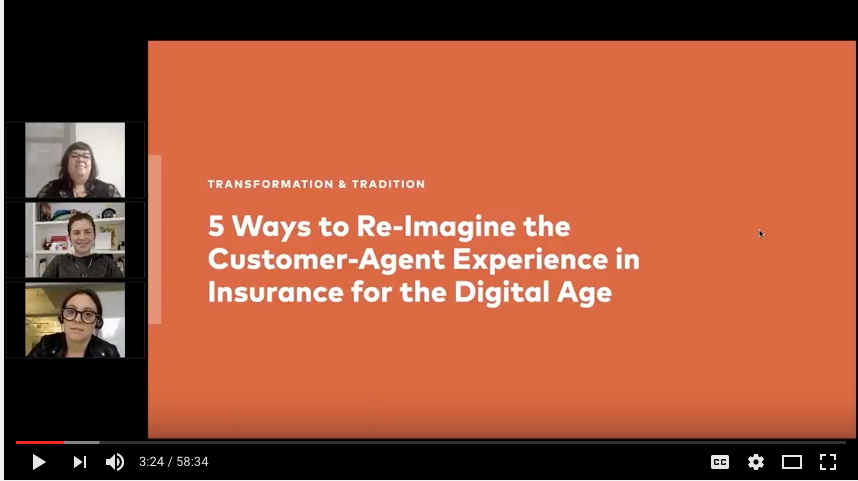
Long gone are the days of the insurance agent a a trusted member of the community with insurance sales taking place face-to-face in the comfort of the living room. Burdensome paperwork and data entry on both sides of the equation combined with clunky technology and a general mistrust between agents, carriers, and customers has made the process of buying insurance long, difficult, and unnecessarily complicated.
Last week we hosted a webinar to discuss how, through a human-centered approach to design and innovation, the insurance industry can re-imagine its own tradition of the customer-agent experience to usher in a new era of digital transformation built on trust, transparency customer needs.
Our presenters included Cake & Arrow’s Director of User Experience, Christina Goldschmidt and Product Strategist, Jane Lindner who discussed their work facilitating large scale innovation projects with clients such as MetLife, ProSight, and more.
Heart and center of the webinar was the idea that user needs must be the force that drives all innovation. And in the insurance industry, consumers, agents, and employees are all a kind of user. Goldschmidt, who has conducted hundreds of interviews and user testing sessions with insurance stakeholders and users, kicked off the webinar with a discussion of how research and usability studies can help insurance companies articulate a vision for service design that includes (and benefits) everyone involved in the insurance-buying process, not just consumers. At the end of the day, focusing on the needs of every user is a win-win, for consumers, agents, and carriers.
Lindner then pivoted to a discussion of how insurance companies often make the mistake of thinking that digital transformation simply involves digitization, when in fact, true digital transformation only occurs when the focus is customer or user centric. Rather than digitizing business as usual, Lindner advises insurance companies to consider whether or not their current processes are working well or are even necessary by focusing first on customer/user journeys, and then designing solutions from there. By pinpointing the moments of greatest vulnerability in the user journey that ultimately determine the brand-customer relationship, insurance companies can innovate high-impact solutions that will transform customer’s experience with their brand rather than investing money into processes that are broken in the first pace.
When the user journey and experience becomes the heart and soul of innovation, insurance companies may discover things they don’t expect, and in the end, design more impactful experiences. Goldschmidt discusses how, in Cake & Arrow’s own research, they discovered that direct-to-consumer isn’t the be all end all in insurance, and that agents still play an important role. For example, when designing MetLife’s first direct-to-consumer sales and servicing platform, they found in their research that while some consumers preferred to complete the entire insurance purchase online, many still preferred to work with agents at different points in the process. The lesson: be there when they need you, but enable self-service. In the end, by giving customers the option to complete their purchases without ever talking to an agent and still offering human touch when it mattered, they were able to create an experience that allowed the technology and the agent to better service their customers, making the process smoother for everyone involved.

In today’s competitive landscape, user experience (along with risk rating models) is one of the only true differentiators for insurance companies, while many still spend millions of dollars on IT initiatives that do little to enable business goals. With insurtech startups now competing on experience, It’s more critical than ever that legacy insurance companies focus their energy and resources on areas that will help them be competitive. Lindner describes how one of the most effective ways insurers can shift spending away from IT and toward customer and user experience is by seeking out best-in-class vendors and software partners to do business with. And in fact, this is already a trend. According to a 2016 McKinsey & CO survey, by 2021 external IT spending will grow from its current level of 33% to 45-55%. Companies will also benefit from moving as much of their infrastructure as possible to a cloud-based on-demand environment. These steps will enable more money and resources to flow into areas that matter most to the business goals.
Clunky technology, obsolete processes and misguided spending have all lead to the breakdown in the customer-agent experience, and ultimately a breakdown in trust between all parties involved in the insurance industry. One of the most impactful ways to rebuild trust with consumers is by re-building trust internally–between carriers and agents. Goldschmidt concludes the webinar by reminding us once again of the importance of focusing on the end-user, in this case the agent. Being easy to do business with goes a long way to support agents in their relationship with customers. Agents will do whatever they can to shield their customers from frustrations they have with the carriers they work with, including choosing a different carrier for their customer’s business. According to a Deep Customer Solutions Inc. survey of 5,000 agents, 99.5% agreed that ease of doing business was critical in choosing which carrier gets the business. The easier carriers are to do business with, the more agents will want to sell their products and services to their customers. Understanding what ease of business looks like for agents involves making them key players in your company’s digital transformation initiatives, and requires that companies valuing agents as their own kind of end user.
The webinar and slides can be viewed in their entirety by visiting this link.